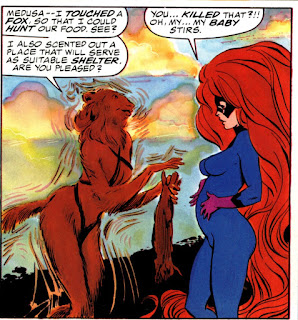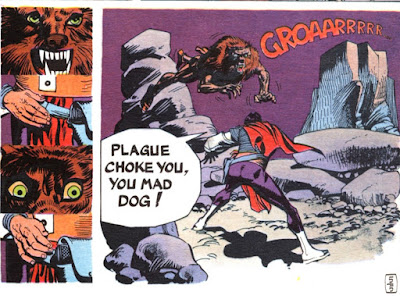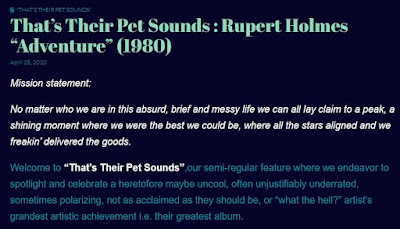The plot gets increasingly difficult to follow. Story beats are tossed in haphazardly, with little effort at coherence (for example, Triton periodically shows up in a parallel plot thread, says something angst-y, and then vanishes) and the corny, cliche-riddled dialogue fails to improve.
Wednesday, June 9, 2021
The Inhumans graphic novel, 1988
The plot gets increasingly difficult to follow. Story beats are tossed in haphazardly, with little effort at coherence (for example, Triton periodically shows up in a parallel plot thread, says something angst-y, and then vanishes) and the corny, cliche-riddled dialogue fails to improve.
Sunday, June 6, 2021
An actual issue of 2000 AD (Prog 449, December 1985)
Prog 449, December 21, 1985
Thursday, June 3, 2021
Book Review: Sword of the Nurlingas
‘Sword of the Nurlingas’ (180 pp.) was published by Berkley Books in January 1979. The cover artist is uncredited, but likely Wayne Barlowe.
This is the first volume in the two-volume ‘Saga of Thorgrim’ series, with ‘Sword of Poyana’, also published in 1979, the second volume. Whether the series was intended to feature additional volumes is uncertain, as these two books are the totality of author Bailey's output.
‘Sword of the Nurlingas’ is set in the province of Bod Dagh, which is modeled on medieval Scandinavia. Our hero, the son of King Thorgill, is serving a stint as foster-son to an elderly couple at the farmstead of Gilistead. Preoccupied with learning the skills of a warrior, Thorgrim largely is sheltered from the political intrigue unfolding in Bodo Dagh, intrigue advanced by the increasing ambitions of Jomunrek, the illegitimate son of Thorgill.
As the novel opens a witch-woman in Gilistead awakes with an alarming vision of fire and violence, a vision that portends a cruel fate for our hero should he be found by the forces of Jomunrek. Gisli, the bailiff of Gilistead, arranges for Thorgrim to flee to the city of Chiavo, where he can find passage to the Eastern Lands and a degree of safety as a future as a member of the royal guardsmen of Bayan.
Gisli bestows upon Thorgrim the magic sword of Lark, and the story of a prophecy…..one that may involve Thorgrim and the Spaehelm, a lost artifact of great power, albeit one that brings a curse upon its wielder.
And so Thorgrim, callow as he is, is forced out into the wide world, with all its perils and promises. But with Lark in his hand, Thorgrim is not one to be underestimated, as his enemies soon will learn…..
‘Sword of the Nurlingas’ was something of a surprise. It’s a cut above the standard-issue Conan pastiche, as good as, if not better, than (for example) the ‘Thongor’ stories produced by Lin Carter.
Bailey is a competent writer who keeps his chapters short and to the point. The cast of characters is expansive, but not unwieldy, and the narrative moves with alacrity. For his part, Thorgrim is not invincible, thus victory is never foreordained. At the same time, his willingness to use strategy and cunning when the odds are against him keeps the plot from getting too predictable and sustains an interesting narrative.
I finished ‘Sword of the Nurlingas’ with an eye towards acquiring the sequel. This is a late 70s sword-and-sorcery tale that is worth picking up.
Monday, May 31, 2021
An Ultimate Alchemist
Saturday, May 29, 2021
Thursday, May 27, 2021
Book Review: Warlord's World
Saturday, May 22, 2021
Adventure and the Yacht Rock sound
Adventure by Rupert Holmes and the 'Yacht Rock' Sound
With the approach of Memorial Day, Sirius XM has revived its Yacht Rock channel, returning a soothing brand of 70s and 80s sound to the ears of its listening subscribers.
Among the more prominent artists on the Yacht Rock channel is Rupert Holmes (the stage name of singer-songwriter, producer, and playwright David Goldstein, b. 1947).
In 1980 Holmes released his sixth album, Adventure, the lead single of which was 'I Don't Need You'.
'I Don't Need You', which can be listened to here, entered the Billboard Hot 100 at slot 84 in the week of April 4 1981, and peaked at slot 56. It's a great example of Yacht Rock: well-crafted, well-produced, and made in the era well before Auto-Tune and Karl 'Max Martin' Sandberg transformed songwriting and producing into exercises in digital wizardry.
Here's a link to an interesting essay at the 'Picking Up Rocks' blog on the birth and development of the songs that typify Yacht Rock radio, with an in-depth review of Adventure.
The reviewer concludes:
........it is a truly seminal Yacht Rock-West Coast-Adult Contemporary-Soft Rock-Pop classic that deserves it’s due because, let’s get “1980” for a second, it’s just totally bitchin’.
You can't beat that sort of endorsement to kick off Yacht Rock season !
Wednesday, May 19, 2021
Book Review: Heatseeker
Sunday, May 16, 2021
Prez, DC Comics, 2016
'Prez: Smells Like Teen President', from Vertigo Visions No. 1 (September 1995) is written by Ed Brubaker and illustrated by Eric Shanower, one of the most acclaimed comic book writer / artist teams of the past 30 years. Brubaker gives the Prez mythology a postmodern 90s spin; the protagonist is a disaffected Grunge rock teen named 'P.J.' who may or may not be the illegitimate son of Prez.




























































.jpg)























